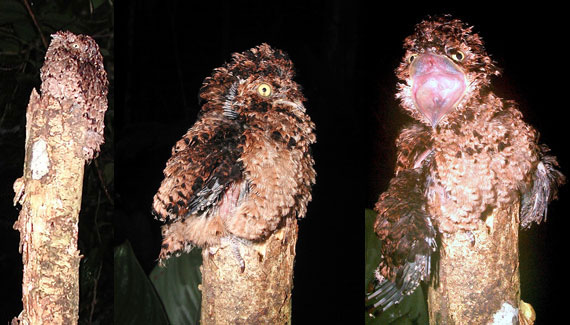Nightbirding leads us to some of the most interesting and poorly known birds we encounter on tour. Guide Bret Whitney‘s photos, video, and text below introduce us to one of the most seldom seen, the fabulous Rufous Potoo of Amazonia. The text and photos are great, but be sure also not to miss the 1-minute video at the bottom of this page.
.jpg)
Of the seven currently recognized species of potoos –- all in the genus Nyctibius (Greek for “night-feeding”) –- the Rufous Potoo is certainly the most distinctive… and the most mysterious. Up until the late 1980s, very few ornithologists had seen one alive, and its voice remained unknown; to this day only a small cadre of researchers and birders has thrown the beam of a spotlight on one. In that moment of epiphany, each and every one of them, without doubt, has marveled at the intricacy of the pearl-spotting on “gold-leaf” (hence the Latin epithet bracteatus) plumage that so sets the Rufous apart from its brethren. It is by far the smallest potoo, too, and it possesses the strangest dark apron at the bottom edge of its pupil, as if a black keyhole were set into the brilliant yellow orb of its iris. The Rufous Potoo has evolved some remarkable life traits and survival strategies. The “nest,” for example, is the exposed top of a vertical, broken stub a few inches in diameter in the understory of terra firme (never flooded) forest. The single white egg is laid, necessarily, with unerring aim. To escape the eyes of predators, adults rely on the camouflage of their plumage augmented, if even slightly threatened, by a slow, steady rocking motion that transforms the speckled, rufous lump of a bird into a dead leaf with holes in it stirred by the breeze! (Watch the 1-minute video below to see this.) The chick is an absolutely adorable creature that resembles a bird only vaguely. Covered in cute little rufous-and-black curls and pinfeathers with a fierce stare and outsized feet to secure it atop its stub, it hopes, best-case, to be passed off as a tuft of rotting vegetation. For those fearful moments, however, the Rufous Potoo chick reserves a threat display as shocking as any I have experienced in the world of birds. If you get too close (as I did only once!), the tiny beast suddenly lunges forward with its mouth hugely open to flash a startling pink gape; it truly made me gasp and shiver, so unanticipated was it. Here’s a collage of three images of a chick: Indeed, the Rufous Potoo is the oddest member of the bizarre and ancient potoo lineage, and recent studies including molecular analysis indicate that it deserves a separate, monotypic genus. If you haven’t yet had the great luck to see a Rufous Potoo, you have a wonderful treat in store for you one day…or more likely, one starry, moonlit Amazonian night. Check out the video below of an adult Rufous Potoo, especially the gentle rocking motion mentioned above (very cool!) and the amazing eye. For best resolution after you’ve started the video playing, click on the “360” button at the lower right to choose the higher-resolution “480” setting. |


